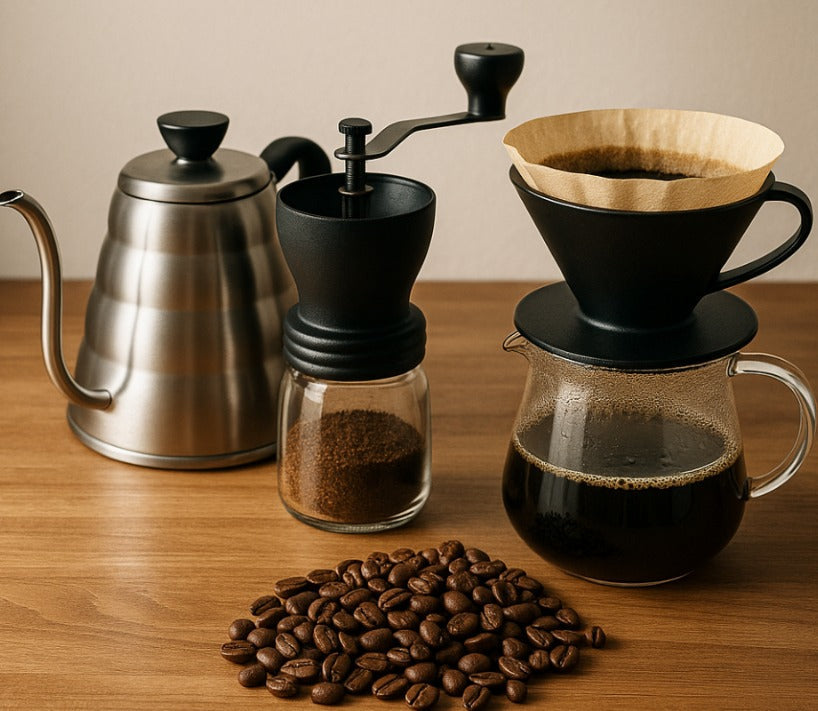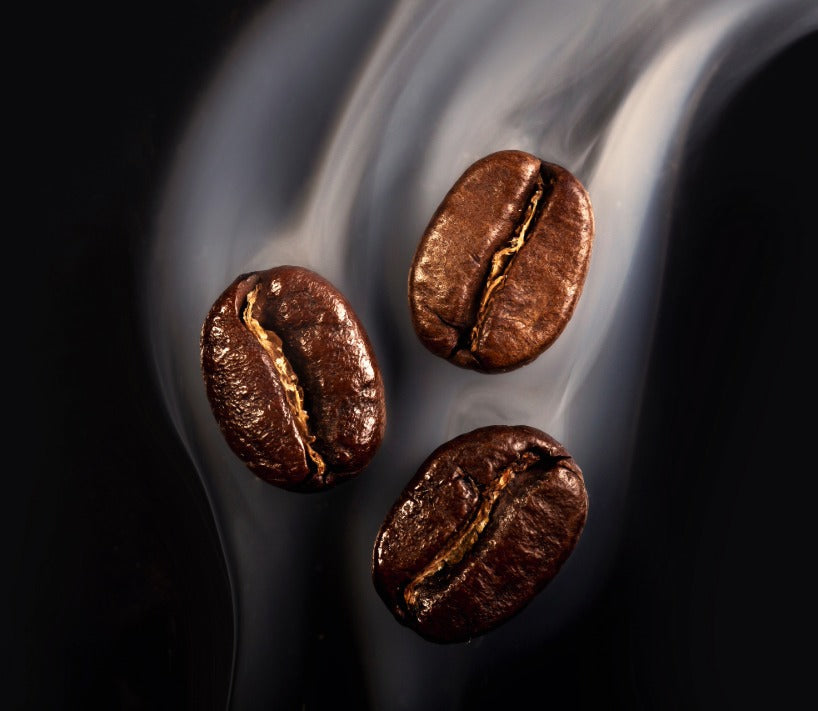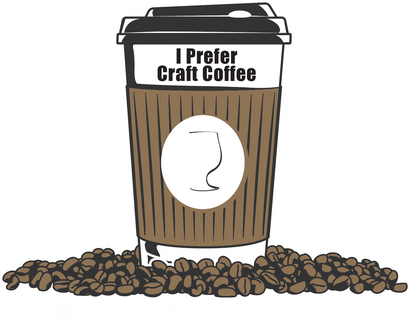Unlocking Top Specialty Coffee’s Best Flavors with the Right Brewing Method
April 04, 2025 10 min read
Bean Beneath the Brew: Unlocking Specialty Coffee’s Best Flavors with the Right Brewing Method
I remember the first time I came across the term “specialty coffee.” I was standing in a local café, scanning a menu that boasted so many coffee origins it read more like a geography quiz than a morning beverage list. My old approach was pretty simple: “Coffee, please. Medium. Cream and sugar.” But I’d started hearing whispers about how single-origin beans and different brew methods could transform a coffee cup into a flavor adventure. Suddenly, my curiosity was piqued—what was I missing out on?
Soon, I realized there was an entire universe beyond that standard drip pot in my kitchen. There were new ways to make my coffee tastier, more nuanced, and maybe even a little exciting. After all, if I’m searching for the best coffee to buy online or scouring the web for the best coffee on the internet, it’s only fair that I understand how to brew it so every juicy, chocolatey, or fruity note stands out like a rock star on stage. Whether you’re a self-proclaimed coffee nerd or you’re simply looking for specialty coffee near me that doesn’t taste like burnt rubber, this post is for you.
In this guide, I’m going to dive into the biggest brewing methods out there—like the pour-over, French press, espresso, and more—to see which ones let specialty coffee flavors shine the brightest. If you’ve ever wondered whether a slow pour-over highlights those floral top notes, or whether immersion-based brewing unlocks chocolaty undertones, buckle up. We’re about to geek out on coffee. Don’t worry, I’ll keep it fun. I promise you won’t need a PhD in Coffee Science (is that even a thing?) to follow along.
1. Why Brewing Methods Matter for Specialty Coffee
Let’s be honest: if you’re chasing the best small batch coffee, or you’re on the hunt for the best craft coffee at home, you want every single bean to count. Specialty coffee, by definition, sits at the upper echelon of quality. These beans typically have unique flavor profiles—think fruit, chocolate, caramel, florals, or even delicate tea-like qualities. It’s no wonder some folks prefer to buy specialty coffee online in search of that perfect origin that matches their palate.
But here’s the thing: a brilliant coffee bean can still yield a mundane brew if you’re using the wrong method. Different brewing techniques extract flavors differently. Temperature, water-to-coffee ratio, grind size, and extraction time are just a few of the variables that can shift your cup from “meh” to “mind-blowing.” Choosing the right method means you can coax out vibrant flavors that might otherwise remain hidden. It’s like having the ultimate backstage pass to the coffee’s secret talent show.
2. Pour-Over: Precision Brewing at Its Finest
If you’ve seen someone gently pouring hot water over coffee grounds in a cone-shaped dripper, you’ve witnessed a pour-over in action. I used to watch pour-over baristas, wide-eyed, thinking, “Wow, that’s fancy.” This method is all about control. You manually adjust the flow of water, ensuring it gently saturates every ground, extracting flavors evenly.
-
Flavor Highlights: Delicate, bright, and nuanced. Perfect if you’re sipping on a lightly roasted coffee with fruity or floral notes, perhaps from East Africa.
-
Why It Works: The thin, paper filter can mute some heavier oils, leading to a cleaner cup where subtle flavors pop. This is especially great for best coffee for non coffee drinkers who might be wary of bitter or overly heavy brews.
-
Pro Tip: Use a gooseneck kettle for a controlled pour. This helps you maintain a steady flow rate—important when you’re trying to highlight the best characteristics of your best tasting whole bean coffee.
Whether you got your beans through top coffee delivered services or you order coffee online from your favorite roaster, pour-over is a stellar method to highlight nuanced complexities. If you’re meticulous and enjoy the process, it can be downright therapeutic, too.
3. French Press: Immersion for Bold Flavors
Next up, the French press. It’s not just a fancy name—okay, maybe it is—but it’s also a timeless method. It involves steeping coarse-ground coffee in hot water for several minutes before pressing down the plunger.
-
Flavor Highlights: Rich, full-bodied, and heavy on mouthfeel. Fantastic for chocolaty, nutty, or caramelly coffees, often from Central or South America.
-
Why It Works: With a metal or mesh filter, more oils stay in your cup, amplifying body and depth. This immersion style also means you get more consistent extraction of flavor compounds. If you’re exploring the best coffee worldwide, there’s a good chance you’ll find a perfect match with the French press.
-
Pro Tip: Don’t let the coffee sit too long after plunging. Over-extraction can lead to bitterness, which drowns out those delicate specialty notes. Four minutes is often the sweet spot.
For those who love a bolder kick and want to capture every ounce of their coffee’s essence, French press is a great option. Just remember to handle it carefully—let it steep correctly, and you’ll uncover layers of flavor you never knew existed.
4. Espresso: A Concentrated Flavor Bomb
Espresso is the rock star of the coffee world—loud, proud, and a little intimidating if you’re a newbie. But there’s no denying it offers an intense snapshot of a coffee’s flavor profile.
-
Flavor Highlights: Concentrated, potentially sweet, complex, and can be quite bright or tangy, depending on the roast and origin.
-
Why It Works: Pressure-driven extraction can create a dense crema on top, which holds aromatic compounds. If you’ve snagged the best specialty coffee online—say a single-origin Brazilian or Ethiopian—espresso can concentrate those tasting notes in a bite-sized shot.
-
Pro Tip: Espresso machines vary wildly in quality and difficulty. If you’re not ready to invest in a high-end machine, you might try simpler methods first. However, if you’re an enthusiast chasing the ultimate coffee expression, learning espresso can be a thrilling (if occasionally frustrating) journey.
Espresso can be a short path to coffee nirvana or a quick trip to bitterness, depending on your technique. Get it right, though, and it’s like tasting the soul of your coffee in one small, powerful dose.
5. AeroPress: Portable, Customizable, and Fun
When I first got my AeroPress, I felt like I’d joined a secret club of coffee enthusiasts who valued convenience without compromising flavor. It’s affordable, compact, and weirdly fun to play with, all while producing an impressive cup.
-
Flavor Highlights: Clean, bright, and surprisingly sweet when done right. It can produce something close to an espresso-like shot if you use certain recipes, but generally it’s a medium-bodied brew.
-
Why It Works: The coffee is steeped, then pressed through a paper or metal filter. This combines elements of immersion and filtration, giving you the best of both worlds.
-
Pro Tip: Experiment with grind size, water temperature, and brew time. The AeroPress is known for its thousands of “recipes,” and part of the fun is discovering which one makes your best craft coffee at home sing.
If you’re someone who likes traveling, camping, or just tinkering with new coffee gadgets, the AeroPress is a super user-friendly way to brew a complex cup. Plus, it’s practically foolproof once you learn the basics.
6. Cold Brew: Icy, Smooth, and Subtle
Hot coffee not your jam? Cold brew might be your best buddy. Unlike iced coffee, where you brew hot coffee and chill it, cold brew involves steeping ground coffee in cold water for many hours—often overnight.
-
Flavor Highlights: Ultra-smooth, low acidity, and sweet. You might miss out on some bright notes that come from hot extraction, but you’ll dodge most bitterness.
-
Why It Works: The cold water extracts flavors slowly, emphasizing sweetness and chocolatey undertones. If you’re always on the hunt for a good coffee to drink black, cold brew is a fantastic option because it’s naturally less acidic and less bitter.
-
Pro Tip: If you prefer bolder flavors, use a slightly higher coffee-to-water ratio. And remember, a cold brew concentrate can be diluted with water or milk to taste.
On a hot summer day, there’s nothing like a cold brew to cool you down. If you’ve gotten your hands on the best tasting whole bean coffee, trying it as a cold brew can reveal surprising flavors you might not have noticed when brewing hot.
7. Moka Pot: A Stovetop Classic
If you’ve ever visited an Italian household, you’ve likely seen a Moka pot. This stovetop wonder uses steam pressure to force hot water through coffee grounds, creating a strong, espresso-like coffee—though technically not espresso.
-
Flavor Highlights: Bold and somewhat intense, but it might lack the crema you’d get with an espresso machine. It’s still a great way to bring out robust or chocolatey notes in medium-to-dark roasts.
-
Why It Works: The pressure is lower than an espresso machine, but still enough to concentrate your coffee. If you want something stronger than drip but simpler than full-blown espresso, the Moka pot sits comfortably in between.
-
Pro Tip: Don’t let the pot overheat. Keep the flame low, and remove the pot from heat as soon as you hear that familiar gurgling sound. Otherwise, you risk scorching those specialty beans.
For those who love a more European style of coffee but can’t justify the cost or complexity of an espresso setup, a Moka pot can be a charming and effective solution.
8. Siphon (Vacuum Pot): A Science Experiment Worth Tasting
Now, if you want to feel like a mad scientist in your kitchen, the siphon is the way to go. It uses vapor pressure and a vacuum to move water between two chambers, extracting coffee in the process.
-
Flavor Highlights: Very clean and balanced. The coffee is usually medium-bodied, with clarity that can rival a pour-over.
-
Why It Works: The vacuum process and cloth filter remove most sediment while preserving aromatic oils. It’s a theatrical way of brewing that does justice to high-end specialty beans.
-
Pro Tip: It can be finicky, and timing is crucial. So if you’re after a no-fuss brew, consider something simpler. But if you love an impressive show (maybe you’re entertaining friends who appreciate good coffee), the siphon is a conversation starter.
Is it overkill for a quick morning cup? Possibly. But if you live for novelty and enjoy playing with science, you’ll have a blast discovering the subtle complexity a siphon can bring out in your best coffee worldwide beans.
Now that we’ve toured the coffee-brewing galaxy, let’s talk about what’s in it for you—beyond just the bragging rights of knowing all these fancy methods.
-
Flavor Discovery: Each brewing method highlights different aspects of your coffee. With the right method, you can uncover hidden fruitiness, chocolate notes, floral aromas, or nutty sweetness. So whether you got your beans from a local roaster, a new “specialty coffee near me” spot, or you decided to order coffee online from an overseas farm, you’ll know exactly how to coax out its best features.
-
Appreciation for Quality Beans: When you invest time in your brew method, you’ll start appreciating beans on a deeper level. It’s no longer just about caffeine; it’s about the terroir, the roast, and the craftsmanship. If you’re wondering “where to buy gourmet coffee” or “where can I buy fresh coffee beans near me,” you’ll also be more selective, seeking out those roasters who clearly care about their product.
-
Experimentation = Fun: Brewing coffee is like cooking—try different recipes, tweak variables, and discover what you enjoy most. It’s a never-ending playground for your taste buds. Plus, it makes for a great conversation starter if you’re serving guests or giving coffee beans as a gift. People are impressed by the smallest details, and you’ll look like a coffee wizard.
-
The Perfect Gift Knowledge: If you’re searching for a gift for coffee lover friends or looking for presents for coffee lovers in your life, you can give them not only beans but also a recommended brew method that complements those beans. That’s way more thoughtful than just handing over a bag of random coffee.
-
Better Morning Ritual: Let’s face it: mornings can be rough. But having a mindful coffee-brewing routine can add a little magic to the start of your day. No matter which method you choose—pour-over for calm precision, French press for bold simplicity, or AeroPress for an adventurous flourish—you’ll feel a sense of accomplishment right before that first sip. And trust me, that first sip always tastes better when you’ve put your own touch on it.
Putting It All Together
If you’ve made it this far, you’re probably as nerdy about coffee as I am—or at least curious enough to read a small novel about brewing methods. By now, you know that each method—pour-over, French press, espresso, AeroPress, cold brew, Moka pot, siphon—extracts flavor differently. Which one is best for highlighting specialty coffee flavors? Well, that depends on the specific beans in your hand and the flavors you want to amplify.
-
If your coffee is lightly roasted and bursting with fruity or floral notes, a pour-over or siphon might be your new best friend.
-
If you prefer a heavier body and richer notes, the French press, Moka pot, or even cold brew can be your go-to.
-
If you crave a concentrated jolt of flavor, espresso or an AeroPress (with the right recipe) can give you that bold explosion.
At the end of the day, there’s no one-size-fits-all. The fun is in experimenting—like a coffee treasure hunt where the “X” marks your perfect brew. Maybe the best craft coffee at home for you means balancing convenience and flavor, or maybe you live for the drama of a siphon spectacle. The beauty of specialty coffee is that it’s meant to be explored.
One thing’s for sure: if you’re going to go through the trouble of searching for the best specialty coffee online or rummaging through your local shops for the best coffee worldwide, you deserve to brew it in a way that does justice to its quality. That might mean investing in a pour-over setup, or dusting off a French press you’ve had for ages, or finally mastering that espresso machine that’s been taunting you from the countertop.
Final Sip
Coffee is an experience, not just a beverage. When you’ve taken the time to find good coffee to drink black, or you’ve discovered a hidden gem from a small farm, it only makes sense to highlight its flavors with the right brewing method. Hopefully, this little expedition gives you the knowledge—and confidence—to play barista in your own kitchen.
So, here’s my challenge to you: Pick one method you haven’t tried yet, pair it with a high-quality bag of specialty beans (maybe a gift from a friend or something you found online), and see what happens. You might just find your new morning ritual is the highlight of your day. No barista certificate required—just a willingness to brew, taste, and explore. Cheers, and may your coffee adventures be filled with delightful surprises!
Also in Best Coffee To Buy Online Education

Freshest Specialty Coffee at Home: Value Over Discounts
November 04, 2025 4 min read
Why many roasters discount beans, why I don’t, and how to build Freshest Specialty Coffee at Home with roast-dated, high-scoring, roast-to-order coffee. Includes a fast plan, a comparison table, and clear buying rules.

Brewing The Best Coffee at Home: Stop Waiting in Line
November 03, 2025 4 min read
Learn Brewing The Best Coffee at Home with a quick Proof → Promise → Plan system: choose fresh, roast-dated beans, use a simple 1:16 recipe at 200°F, and lock a 4–6 minute routine that beats the drive-thru on taste, time, and cost.

Best Tasting Coffee At Home: Stop Buying “Deals,” Start Buying Value
November 02, 2025 4 min read
Want the Best Tasting Coffee At Home? Skip old ‘deal’ beans. Use fresh, high-scoring, air-roasted coffee and a simple 1:16 plan. This guide shows proof, a clear promise, and a step-by-step plan to order smart, brew better, and enjoy sweeter, cleaner cups—daily.
